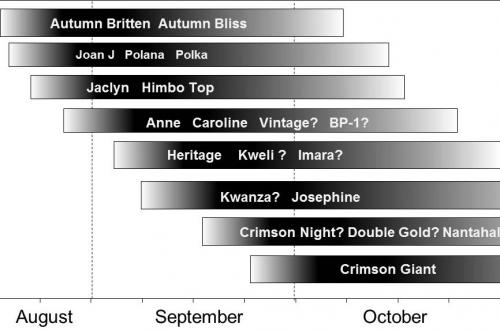Fall-fruiting raspberry varieties for 2017
New and standard raspberry varieties are reviewed and discussed for commercial production.

Fall-fruiting or primocane fruiting raspberries produce in late summer and fall on the current year primocanes. They differ from floricane fruiting types that produce berries on the second year canes in the middle of summer. Primocane fruiting types are popular because they can be pruned inexpensively, but fruit also ripen late in the season when spotted wing Drosophila populations are high. If you are growing these varieties, be prepared to manage these flies that can infest the fruit.
There are numerous older primocane fruiting varieties and many new types to choose from. We have been able to assess these types in southern Michigan with funding through the NIFA Specialty Crop Research Initiative (TunnelBerries). Here is a summary of variety choices for Michigan and the upper Midwest.
Harvest times
Choose varieties that ripen early enough to pick high yields for your region. Earlier maturing types are best for short growing season locals, and early and later maturing types are suitable for areas with longer growing seasons. The chart below provides general harvest times for primocane fruit in southern Michigan. Move the bars to the right in more northern locations.

General harvest times for primocane raspberries in high tunnels in southern Michigan. Relative harvest volumes increase with bar darkness. Varieties followed by (?) are only estimated.
Early types
Polka and Joan J are the two that have performed best for us. Both are high yielding with excellent quality. Polka has bright red, glossy fruit that are firm and tasty. Joan J also has excellent flavor and firmness, but fruit are a darker red. Joan J canes are thornless.
Himbo Top is a little later maturing but extremely productive and easy to pick. Berries are large and lighter red, but have an average flavor and are less firm, so they may not pack and ship as well. Jaclyn has very flavorful, firm berries, but is not grown widely because yields are modest and berries are darker.
Mid-season varieties
Caroline has been a popular variety this season because it is extremely productive and has an outstanding flavor. Caroline berries are somewhat less susceptible to gray mold, but a little bit soft. Plants produce abundant canes. Another mid-season type to consider is Anne. Anne is the best yellow-fruited variety we have seen. Berries are somewhat soft but are large and have a unique, pleasant flavor. Heritage is an old standard that fruits later than Caroline or Anne. It is a consistent producer, but has been replaced for the most part by larger varieties with larger fruit.
Three new mid-season types should be tried. Imira and Kweli are new from Europe. Both look to be productive with excellent fruit quality. Imira is a little earlier fruiting than Kweli, and very firm, uniform medium red, glossy berries. Kweli is also very firm but a little darker red. Both appear to be productive and have excellent flavor. Vintage is the third new type. Berries are a uniform lighter red with excellent flavor. Vintage fruit appear a little softer and the productivity in Michigan is not clear.
Late-season varieties
Varieties maturing later than Heritage should be considered only for southern Michigan or further south, or for production in high tunnels where fruiting begins earlier. Josephine is a very productive variety with excellent flavor and fruit size. The dark red color has limited Josephine use though. Kwanza is a new European type that may become useful. In limited trials, it appears to have high yield potential. Berries are a light red and very large and firm. Growers in longer season locations should take a look at Kwanza.
Crimson Night and Double Gold are two interesting new late types. They are likely too late to grow in most of Michigan (unless under tunnels), but both produce firm, flavorful fruit. Crimson Night is a very dark red and Double Gold is a yellow berry with a pink tint.



 Print
Print Email
Email


